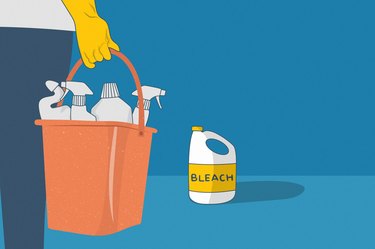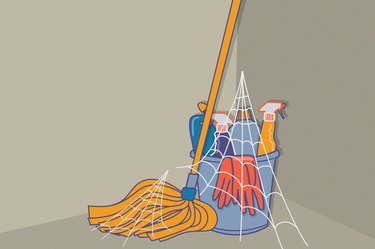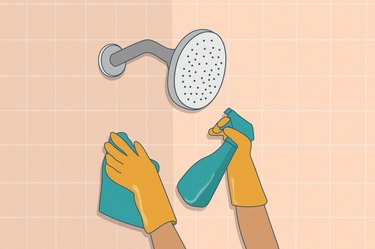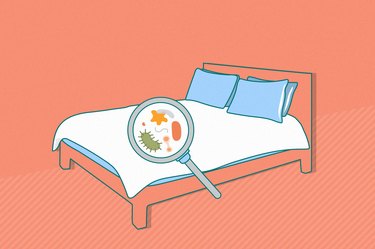
Good, old-fashioned chlorine bleach may seem to some like the castor oil of cleaning products, but it's hard to deny its effectiveness and versatility.
The basic chemicals in bleach not only whiten whites and erase stubborn laundry stains, they also kill a wide range of bacteria, molds, mildews, algae and viruses, including the coronavirus, according to a June 2023 article in StatPearls.
Video of the Day
Video of the Day
Bleach does so many jobs around the house, and it costs a tiny fraction of what you might pay for the latest trendy cleaning product, but how safe is it to use bleach?
As it turns out, bleach is safest to use by itself — although it is toxic and should always be diluted with water and used as directed. It potentially becomes a lot more toxic when it's mixed with certain cleaners and chemicals, even things as harmless as vinegar, says Shireen Banerji, PharmD, director of the Rocky Mountain Poison Center.
Although that doesn't always stop people from mixing bleach and other cleaners or chemicals — both on purpose and by accident. "Many folks know that mixing bleach with other cleaners could be dangerous, but there are still many folks who believe that they will make [bleach] work better by mixing it with other cleaners or chemicals," Banerji says. "We urge folks to never mix bleach with any chemicals and to follow manufacturer directions."
Here's everything you need to know about cleaning with bleach and things you should never mix it with.
Warning
Never mix bleach with anything but plain water. Mixing bleach with acids or other cleaners can produce a dangerous gas that is potentially lethal.
What Is Bleach?
First, a little background: Liquid chlorine bleach — what many of us call "regular" bleach or simply by the most familiar brand name Clorox — is primarily a mixture of water and sodium hypochlorite, a chemical known to chemists as NaOCI. Clorox and other liquid bleach products often include small amounts of additives, including sodium hydroxide (NaOH), to stabilize the solution and enhance cleaning performance.
Non-chlorine bleaches, such as the various "oxygen bleach" laundry products, do not contain sodium hypochlorite. They make great color-safe detergents and stain removers, but they typically are not used for household disinfection or sanitization.
Chlorine bleach is made by passing electricity through saltwater, then processing the resulting reaction to create sodium hypochlorite, according to the Clorox site. When used for cleaning, bleach is exposed to organic materials and/or sunlight, causing it to break down into saltwater. This is why it's safe for the environment to pour or flush diluted bleach down the drain after use.
How Does Bleach Work?
Sodium hypochlorite removes pigment — aka bleaches things — through a process called oxidation. It breaks down the parts of pigment that reflect light, making it non-reactive and therefore devoid of visible color, per the StatPearls report. When bleaching fabrics to remove stains, some of the stain material may remain in the fabric, but you don't see it because its color is gone.
For disinfection, chlorine bleach denatures, or unfolds, the proteins of bacteria and other organisms, causing them to clump together. Once clumped, the proteins are no longer harmful, and this process cannot be reversed.
Why It’s Bad to Mix Other Cleaners With Bleach
Surprisingly, if you check the product label on one of the leading brands of liquid chlorine bleach, you have to look pretty hard through the fine print to find warnings against mixing bleach and other cleaners. And even there the language is curiously vague. So let's be clear: Never mix bleach with any other household cleaner for any reason.
First, it's not necessary or beneficial to mix bleach with other cleaners. Second — and far more important — mixing bleach with ammonia or acids creates a toxic gas that can cause a number of symptoms and, in extreme cases, is potentially deadly.
Mixing Bleach and Ammonia
Banerji explains why you should never mix bleach with anything containing ammonia — and how this can happen by accident: "Using bleach to clean up animal urine may not be considered 'mixing chemicals,' but by doing so, one can create a gas called chloramine when bleach mixes with ammonia-based compounds such as urine."
The gas chloramine can irritate your nose, throat and eyes, she explains. "It makes you cough, and for those with delicate lungs, it could precipitate shortness of breath, wheezing and distress."
Mixing Bleach and Acid
Mixing bleach with strong acid creates chlorine gas, which can be even more hazardous than chloramine gas, according to the Washington State Department of Health. Exposure to low levels of this gas over short periods of time can make your eyes burn and your nose run, and you may cough or experience breathing problems.
More severe or prolonged exposure can lead to vomiting, difficulty breathing, fluid in the lungs and pneumonia, and extreme exposure can even be lethal. One such case occurred in 2019 when a restaurant worker mixed bleach-based and acid-based cleaners, inadvertently creating a toxic gas that led to the death of the restaurant's manager, according to CNN.
When chlorine gas contacts moist surfaces, such as those in your eyes, nose, throat or lungs, it becomes hydrochloric acid, which causes tissue damage, per the StatPearls article.
What Not to Mix With Bleach
When you're cleaning or disinfecting with bleach, you can follow this simple rule to stay out of trouble: If it's not plain water, don't mix it with bleach.
But there are plenty of situations where you can inadvertently mix bleach with other cleaners or substances and potentially create a dangerous situation.
For example, let's say you're cleaning your bathroom tile or countertops with a vinegar-water solution, then you run into some stains that call for a stronger cleaner. So you pour a little bleach into your cleaning bucket and — boom — you've just created a toxic gas.
Never Mix These With Bleach
- Ammonia
- Toilet bowl cleaner
- Drain cleaner
- Glass/window cleaner
- Vinegar
- Rust remover
- Brick/concrete cleaner
- Descaling cleaner (such as CLR)
- Urine (might be present in a toilet bowl, litter box or diaper pail)
- Oven cleaner
- Hydrogen peroxide
- Insecticide
- Pool chemicals
- Dishwasher detergent
How to Use Bleach Safely
When used improperly, bleach by itself can be hazardous — to you and parts of your home. Undiluted bleach is corrosive and can damage many surfaces and materials, including your skin. Even diluted bleach should not be used on some types of metal or natural stone.
Bleach is safe to use if you follow the product instructions. That includes diluting the bleach with the right amount of water for the intended use and taking a few safety precautions. In general, follow these safety measures from the Centers for Disease Control and Prevention when cleaning household items and surfaces with bleach:
- Never mix bleach with ammonia or any other cleaner.
- Wear rubber or other non-porous shoes, gloves and eye protection.
- Try not to breathe in product fumes. If using products indoors, open windows and doors to allow fresh air to enter.
When you've finished with your cleaning, follow the advice on the Clorox label and wash your hands with soap and water before eating, drinking, putting anything into your mouth (like gum or tobacco) or going to the bathroom.
Different people can be more or less sensitive to bleach, Banerji says, so pay attention to how you feel when using bleach. "Bleach is generally safe when used as directed. Common sense should not be ignored, and one should pay attention to their body, as everyone can react differently," she says.
If you start to feel irritation in your eyes, nose or throat, "take action to ventilate [the area] better and/or take a break. Bleach is not a silent 'offender' so if you pay attention to warning signs you can limit your exposure and mitigate adverse effects, if any," she says.
She offers the following tips for safe use and storage of bleach:
- Never transfer bleach, or any other chemical for that matter, to another bottle.
- Keep cleaners in their original containers. If you have an adverse reaction or accident, the label can be very informative to health care providers, poison center specialists and others trying to help.
- Keep cleaners up high and out of reach from children and pets.
- If an exposure happens, call your local poison center 24/7 for advice.
FAQ
Common Questions
Can you mix bleach and vinegar?
No. Mixing bleach and vinegar causes a release of toxic chlorine gas that is harmful to your eyes, nose, throat and lungs and can suffocate you, according to the Washington State Department of Health. Never mix bleach and vinegar.
Can you mix bleach and baking soda?
Baking soda can be used along with bleach to whiten clothes in the laundry. Arm & Hammer recommends using 1/2 cup of baking soda and 1/2 cup of bleach in a load to soften the water (making the bleach more effective) and reduce the residual odor of the bleach.
What happens when you mix bleach and ammonia?
Mixing bleach and ammonia causes a release of toxic chloramine gas that is harmful to your eyes, nose, throat and lungs. Never mix bleach and ammonia.
Can you mix Pine-Sol and bleach?
No. According to the Pine-Sol website, you should not mix any of the brand's products with other cleaners because the mixture can release hazardous gas.
Can you mix Fabuloso and bleach?
No. You should not use any of these products with chlorine bleach, according to the Fabuloso website:
- Fabuloso Professional
- Fabuloso 2X Concentrated Formula
- Fabuloso Antibacterial
- StatPearls: "Bleach Toxicity"
- Clorox: "Bleach Facts"
- Washington State Department of Health: "Dangers of Mixing Bleach with Cleaners"
- CDC: "Cleaning and Sanitizing with Bleach after an Emergency"
- Pine-Sol: "FAQS"
- Fabuloso: "Frequently Asked Questions"
- Arm & Hammer: "Boost Your Bleach"
- CNN: "A Buffalo Wild Wings general manager died after being exposed to toxic fumes from cleaning agents"
Is this an emergency? If you are experiencing serious medical symptoms, please see the National Library of Medicine’s list of signs you need emergency medical attention or call 911.



